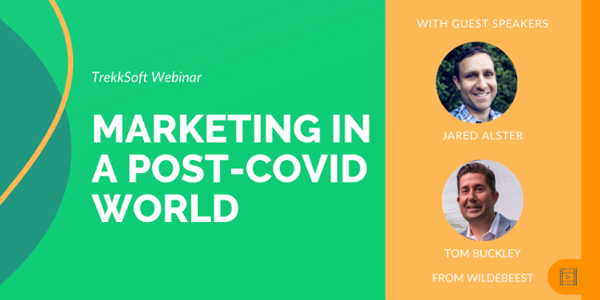This is a two-part series on SEO written by Joe Robison at Green Flag Digital. You can find the second part here.
Tour and activity operators are by and large highly dependent on organic traffic - and it’s an exceptionally powerful channel.
With paid search ad prices on Google Ads and Facebook getting more and more expensive, tour operators are increasingly investing in SEO to grow long-term traffic for their business.
Before we start...
SEO does not offer quick results and measurable ROI down to the penny, but for those who have the long-term vision and patience to make it work, it can bring the most reliable and valuable traffic to your business.
SEO is confusing because Google wants it to be. While the algorithm has some core principles that remain evergreen, with revenue of over $130 billion a year, Google relies on keeping the true mechanics of search ranking factors mysterious to protect their lead search engine market share.
Nevertheless, there is a lot of research that has uncovered the strongest factors that affect rankings. With over 3,200 changes to the algorithm in 2018, here’s what you need to know to improve organic traffic for your tour or activity business in 2019 and beyond.
1. Intent is king in 2019 and beyond. Solve for Searcher Task Accomplishment.
Google has never wavered from repeating their first of ten principles: “Focus on the user and all else will follow.”
In fact, in almost every algorithm update, they point to improving the user experience as their main goal. In a recent update they reiterated that:
“We understand those who do less well after a core update change may still feel they need to do something. We suggest focusing on ensuring you’re offering the best content you can. That’s what our algorithms seek to reward”.

Google’s goal is to solve for the user’s search intent, and help accomplish a specific task.
As stated by Rand Fishkin of Moz, Google is essentially asking “Are they actually solving the problems searchers seek answers for?”
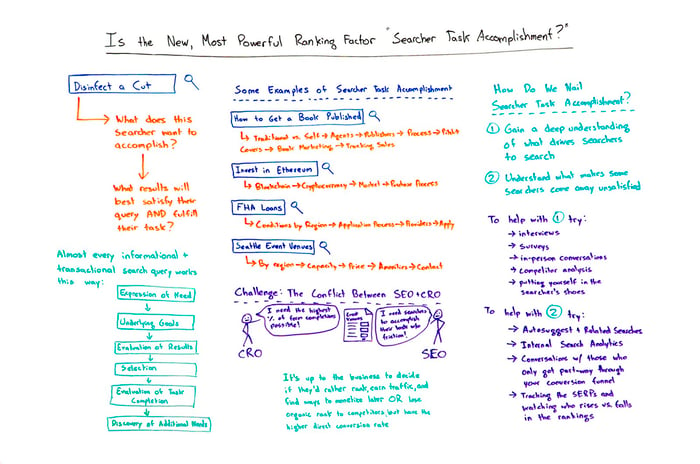
As Rand states in the video:
“Google is going to reward results that help me accomplish the task, discover additional needs, and solve those additional needs as well, rather than the ones that maybe provide a slice of what I need and then make me go back to the search results and choose something else or change my query to figure out more.”
This means Google wants to display the correct types of pages that users are looking for. By types of pages, we mean when a user is looking for a how-to guide, they want to see a blog post. When they’re looking to book a tour, they want to land on a page that lets them purchase online.
What does this mean for tour and activity operators? For your priority keywords, be sure that you’re showing the right page layout and content that matches the keyword the searcher will use.
If a user is searching for “Ireland tours”, you want to show them a list of recommendations like how Authentic Vacations does:
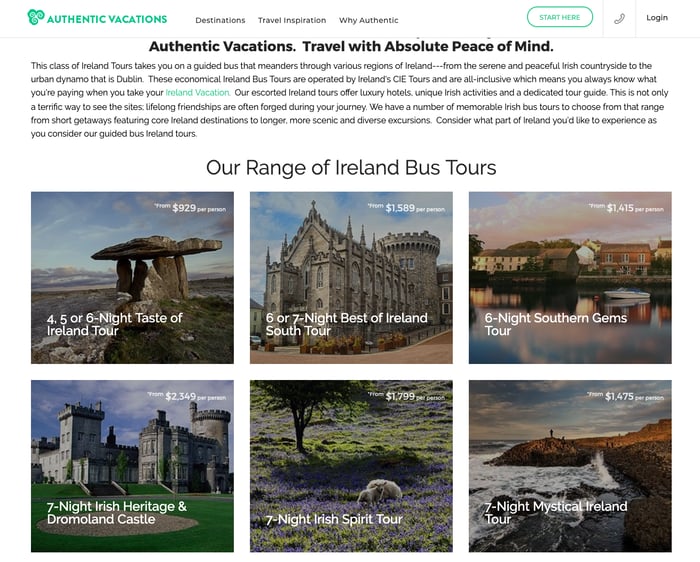
The user wants to see a lot of options for their general search, which includes a variety of locations, prices, and features of the tours.
Conversely, this page by Traverse Journeys doesn’t do so well because they’re just focusing on a single option for the tour and they don’t provide a broad enough range of options.
Key Takeaway
When we think about intent, we want to get into the mind of the user, and this changes for each keyword you're targeting. Someone searching for “Ireland travel guide” is looking for a different page layout and structure compared to someone looking for “Galway luxury hotel”.
2. Beyond keywords with topic coverage, go deep into your tour offer pages.
This brings us to the next point. You can support the searcher task accomplishment by answering enough questions and covering enough topics so that your page becomes the best available resource.
We want the content itself to cover the right topics and entities.
But, what exactly is an entity?
It’s not a keyword, nor is it just a topic. According to an analysis of Google’s “Related Entities” patent, an entity “is not simply a person, place or thing but also its characteristics. These characteristics are connected by relationships.” Google has a database of known entities to further understand the relationships between content and words on the page. It’s a bit of an advanced topic, but a good concept to keep in mind. Google has moved beyond pure keywords into more advanced understanding of articles and pages.
Entity salience is defined by Cyrus Shepard of Moz as:
“Entity salience goes beyond traditional keyword techniques... for finding relevant terms in a document by leveraging known relationships between entities. An entity is anything in the document that is distinct and well defined.”
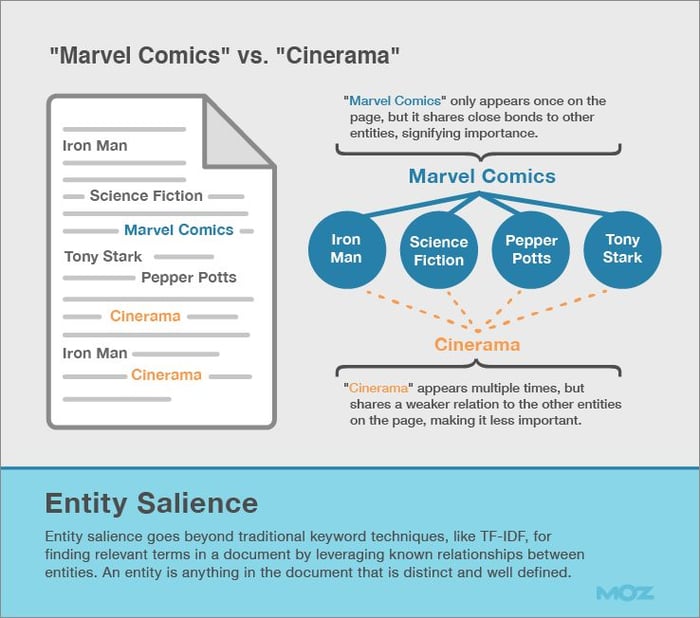
(You can read Google’s research report if you want the nerdy version.)
In plain English, this means that rather than relying purely on strict keyword usage in the past, Google can better understand related entities, how close they are, and how relevant that makes them for the topic of the page.
As stated in the linked video above, “Google is also going to reward... [content] that give[s] me all the information I need, that help me accomplish my task before they ask for something in return.”
So, if Google wants to reward giving all the information the searcher needs, how do you do this?
Traditionally, simply including and writing with the main keywords targeting a page was enough - and in some cases it can be enough if your competitors are not sophisticated. But more advanced websites are using tools and research to discover additional topics and entities that searchers want to see.
Key Takeaway
As a quick how-to for tour and activity operators, you should start with your base keywords, but also research and look into related questions and topics on the subject. Look at the first page of your search results - what do they cover on the topic? Cover those same entities and aim to make your content at least 30-50% better than the best ranking page.
This guide from Bernard Huang on Clearbit outlines the method in researching and combining topics into one piece to ensure full coverage.
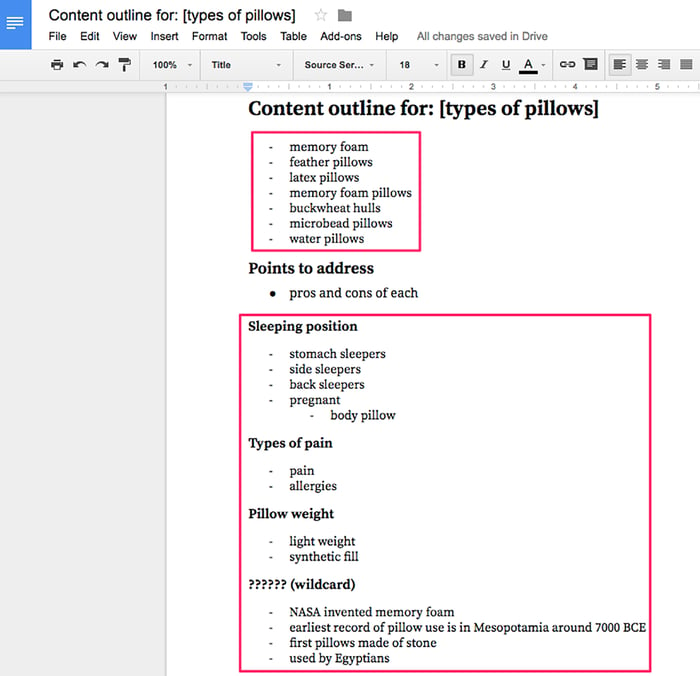
There are some advanced tools out there, such as Clearscope and MarketMuse that help understand and predict entity salience, using Google NLP API as well as IBM Watson. What these are truly getting at is trying to understand and mimic how a subject matter expert writes authoritatively about a topic.
For those just beginning to get into this practice, use your own knowledge as the expert to upgrade your initial pages, then move onto these (expensive) tools when you're ready to scale it up!
3. The Topic Cluster Strategy
To cover a topic in detail, write the main overview of the subject on a “pillar” page, then drill down into individual topics on separate pages known as “cluster” pages. Then, link your “cluster” pages to the main “pillar” page. This concept of arranging your content is referred to as Topic Clusters or Content Clusters.
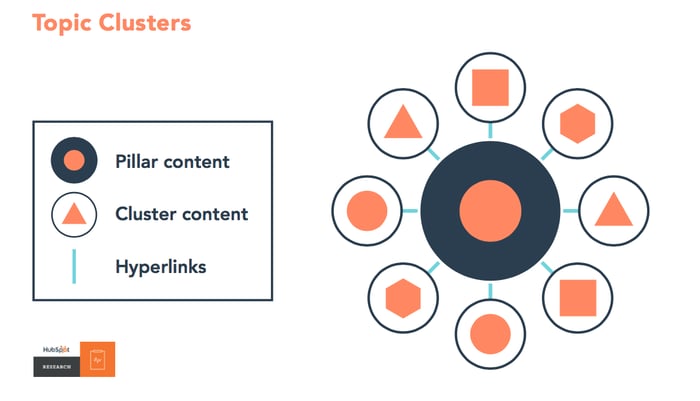
While this mainly applies to more blog post oriented subjects, there can be a strong use case when connecting your main tour and activities page with more informational supporting pages.
For example, on SouthAmerica.Travel’s Brazil page, they show at the bottom of the page a ton of additional information that the user may need before deciding on their trip.
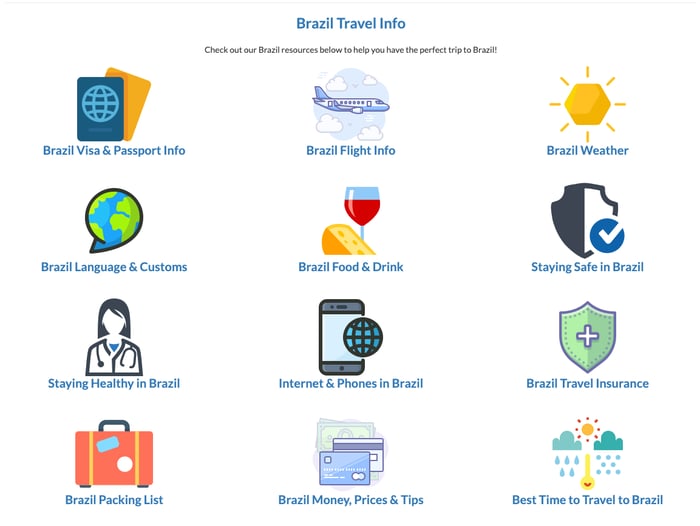 Since it would be overwhelming to show all this content on the main Brazil pillar page, it makes sense to use the topic cluster model to connect all of these pages together. For example, you can provide more information on packing with the Packing List page and then link it to the main Brazil page to indicate relevance.
Since it would be overwhelming to show all this content on the main Brazil pillar page, it makes sense to use the topic cluster model to connect all of these pages together. For example, you can provide more information on packing with the Packing List page and then link it to the main Brazil page to indicate relevance.
Key Takeaway
Identifying pages and topics to turn into a topic cluster requires a combination of brainstorming as the subject matter expert, paired with research into the search results and keyword research.
For detailed implementation, check out HubSpot’s topic cluster guide.
4. Show Expertise, Authority and Trust - but don’t obsess
If you want to start a debate among SEO nerds, ask them about “E-A-T”, which stands for expertise, authority, and trust.
With the “Medic” update in August 2018, and the following Google Core Algorithm updates periodically since then, there has been a vocal part of the community claiming that Google can fully understand E-A-T in websites and adjust rankings accordingly.
Some who are fully bought into the concept believe that Google can understand the quality of a site with some elements such as Better Business Bureau ratings and the presence of an author’s name on the page.
There’s also the notion that Google can understand authorship and the credentials of an individual author, which is debatable.
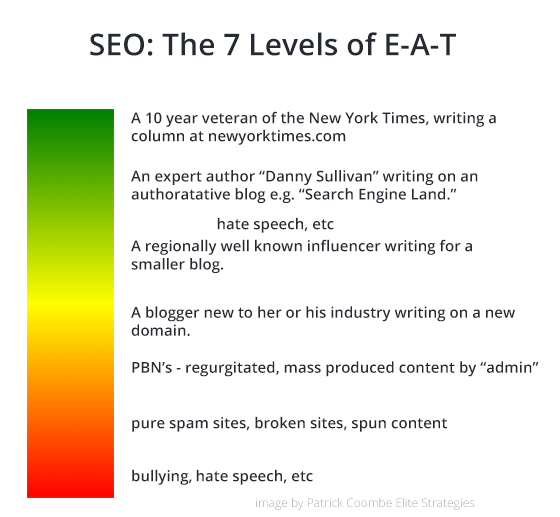
A clear example of a site’s trust signal is their “About Us” page, like Trekksoft’s:
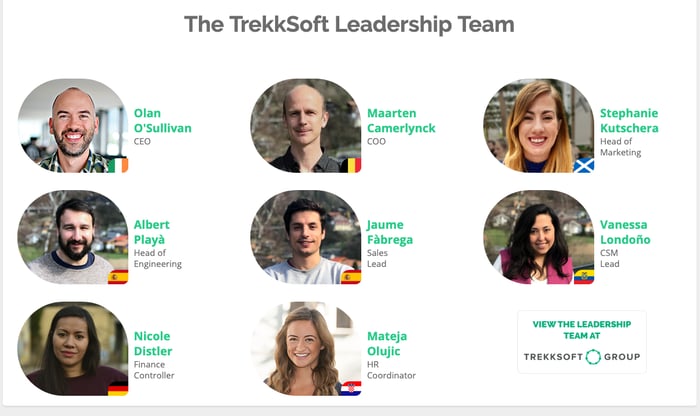
I’m not fully convinced Google can incorporate such subtle signals significantly into their algorithm, and there are lots of dissenting voices about it, which is a common occurrence and point of confusion for SEO clients. Google has suggested that they’ll take some of the same factors of E-A-T and aim to identify them algorithmically.
The truth of the matter is that in YMYL (your money or your life) industries, for instance in the medical and finance industries, established sites have seen surges in traffic since August 2018, while some popular sites with debatable quality have seen rapid declines.
When looking at some travel industry sites myself, I’ve seen more of a decline for sites with weaker backlinks, not so much a problem with E-A-T.
Key Takeaway
You want to show travellers that your company is an expert in the field, that you provide authoritative content, and that your site is trustworthy enough for someone to give you their credit card information.
I would caution against spending a monumental amount of effort in this sphere. Instead, I focus on building quality backlinks and create better content on your site.
5. Optimize your site for mobile
We now live firmly in a mobile-first world and most web traffic, especially in consumer services like travel tours and activities, come from mobile devices.
To further support this connection to SEO, Google has rolled out mobile-first indexing for over 50% of websites. This means they’re now crawling the mobile version of your site and not just the desktop version.
Some related elements to consider in relation to mobile is speed, above-the-fold content, and the display of elements on the mobile screen.
I became particularly fascinated with above-the-fold content and SEO, and in my research, I found a strong correlation with top ranking sites in some of the most difficult industries such as credit cards:
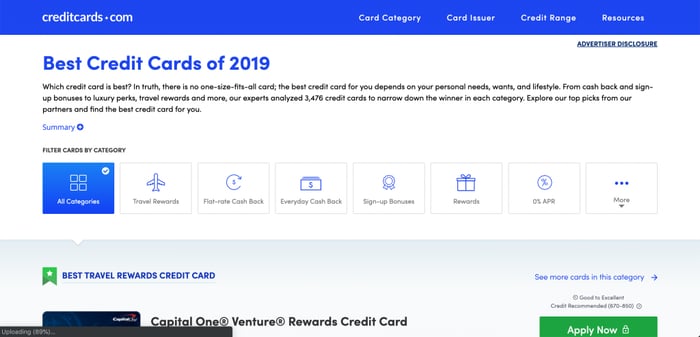
In the travel industry, we also see some high-traffic best-in-class sites doing this as well. Take REI as an example:
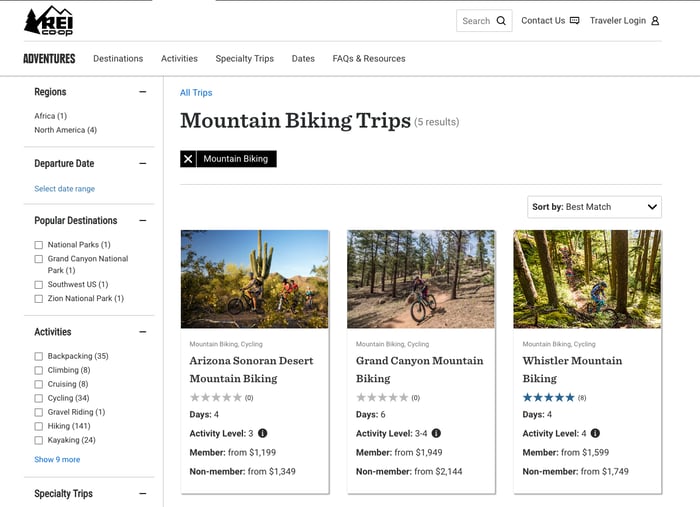
And Tours4fun:
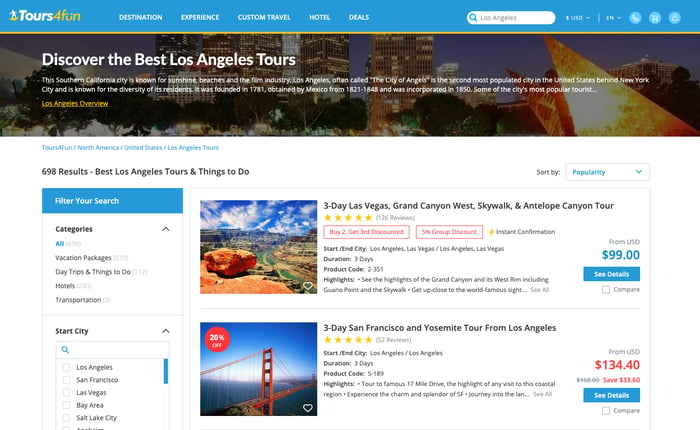 Key Takeaway
Key Takeaway
Beyond ensuring that your site is mobile-friendly, you should audit the site and ensure that it:
- Works fast on your smartphone
- Has above-the-fold content
- Includes the same content on mobile ands desktop
- Doesn’t use a mobile subdomain
- And much more
The best place to start is with Google’s own Mobile-Friendly Test tool.
Read part 2 of the article here.
Want more advice on SEO? Check out this webinar:

